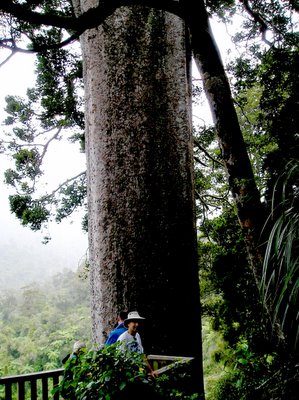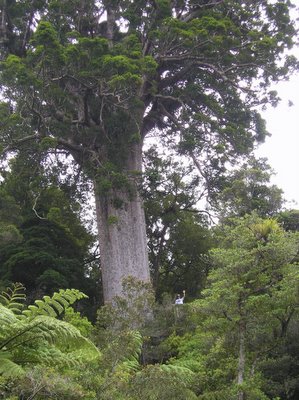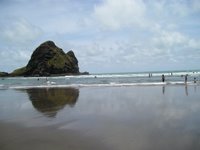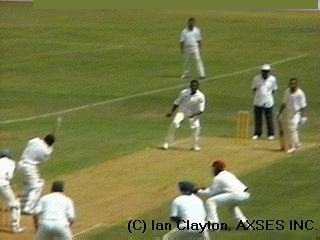
New Zealand is in the southern hemisphere, but besides the seasons, we keep finding other things that are reversed, too.
Some examples of upside-down-ness:
• Yes, the seasons are reversed. It's January right now and it's 80º here. For a split second, we can't understand why on earth the news is showing so much snow in New York ... oh yeah, it's winter up there.
 • The experts say there's different constellations visible down here. I wouldn't know, because I never could find the Big Dipper when I lived in the northern hemisphere, so don't count on me seeing the Southern Cross now that I'm in the southern hemisphere. But the experts say it's there. The Southern Cross constellation is actually on the New Zealand flag, so I guess I have seen it in a way. My niece also wanted to know if we see a different upside-down face of the moon. Beats me. Anyone know the answer to this?
• The experts say there's different constellations visible down here. I wouldn't know, because I never could find the Big Dipper when I lived in the northern hemisphere, so don't count on me seeing the Southern Cross now that I'm in the southern hemisphere. But the experts say it's there. The Southern Cross constellation is actually on the New Zealand flag, so I guess I have seen it in a way. My niece also wanted to know if we see a different upside-down face of the moon. Beats me. Anyone know the answer to this?• There's also the popular story about toilets swirling the opposite direction in the southern hemisphere. I'd like to say that I have done first-hand research on this - I actually went to the airplane toilet just after we passed the equator and watched it flush. But there was so little water that I couldn't tell. We also examined the hotel toilet with the same disappointing conclusion. Once we moved into our house, I continued my research without success. Kiwis are very conscious of conserving water, apparently. So I looked it up online and found an explanation on a website written by Penn State's Earth and Mineral Sciences department. (http://www.ems.psu.edu/~fraser/Bad/BadCoriolis.html) It says that the direction it drains depends more on the shape of the bowl and the position of the drain than the hemisphere. If we had a perfectly spherical bowl with water draining exactly in the center, we could test it in 2 different hemispheres and maybe barely see the Coriolis effect. It does exist, but it is barely discernible. Mostly, that whole swirl story is urban myth with a little science thrown in.

• You turn on a light switch by pushing the switch DOWN. This explains why I am frequently walking in a dark room, I guess.
(the switch on the right is ON)

• Along those lines, every outlet has a switch on it, too. Which must be flipped down (of course) in order to get power. So you have to turn on the outlet AND turn on the hair dryer to get it to work. If only this could explain my bad hair days. (these outlets are ON)
• The hot water comes out of the right-hand faucet in our house, although I have seen it on the left in other places. Anyway, I keep brushing my teeth with warm water. Ew.
• Since Kiwis drive on the left, they also tend to walk on the left side of the sidewalk (called a footpath). Consequently, we frequently find ourselves dodging other pedestrians whenever we forget to stay on the proper side.
 We also cause crashes in the grocery store as we drive our "trolleys" on the wrong side of the aisle.
We also cause crashes in the grocery store as we drive our "trolleys" on the wrong side of the aisle.Speaking of which, since they drive on the left side of the road, it ALSO means...
• ... the driver's side of the car is on the right now. When Curt and I are going someplace, I keep walking to the wrong car door to get in as a "passenger" and find myself staring at a steering wheel. How did that get there?
• ... the turn signal is on the right, which is not where I'm used to it being. As a result, I keep hitting the windscreen wiper whenever I'm turning left. I definitely have the cleanest windscreen in the country.
• ... the seat belt is attached to the frame over my RIGHT shoulder. I need to buckle and unbuckle it near my LEFT hip. My instincts still reach to my right hip. At which point I find myself inexplicablly pinned in the car. Help! I can't get out!
 • ... the gear shift is on the left. So I have to shift left-handed. Which is not my most coordinated hand. One of these days, I'm going to be in Reverse instead of Park. Yikes!
• ... the gear shift is on the left. So I have to shift left-handed. Which is not my most coordinated hand. One of these days, I'm going to be in Reverse instead of Park. Yikes!• ... when we're driving on the motorway, the slow traffic stays LEFT. The speedsters whiz past us on the right. The exits are off from the left, too.
99_f.jpg)





























